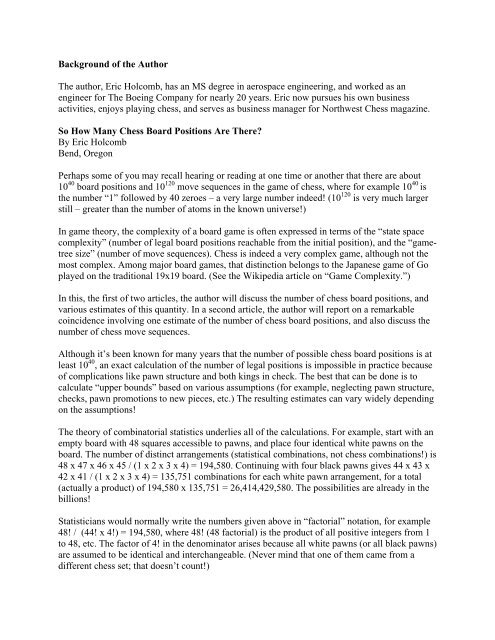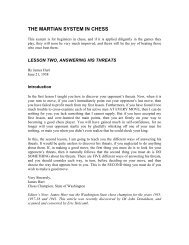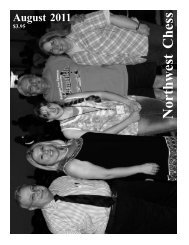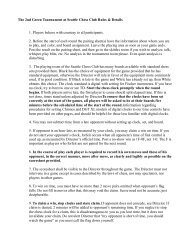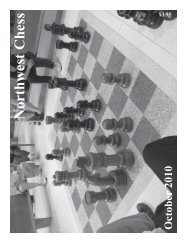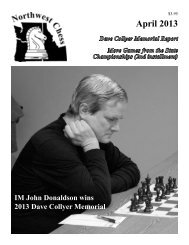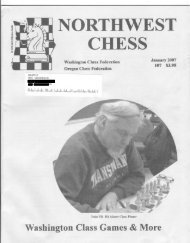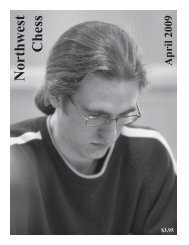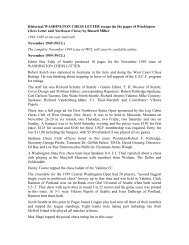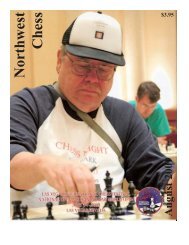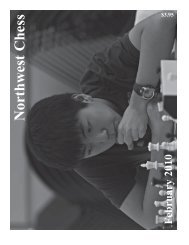Chess Board Positions article - Northwest Chess!
Chess Board Positions article - Northwest Chess!
Chess Board Positions article - Northwest Chess!
Create successful ePaper yourself
Turn your PDF publications into a flip-book with our unique Google optimized e-Paper software.
Background of the AuthorThe author, Eric Holcomb, has an MS degree in aerospace engineering, and worked as anengineer for The Boeing Company for nearly 20 years. Eric now pursues his own businessactivities, enjoys playing chess, and serves as business manager for <strong>Northwest</strong> <strong>Chess</strong> magazine.So How Many <strong>Chess</strong> <strong>Board</strong> <strong>Positions</strong> Are There?By Eric HolcombBend, OregonPerhaps some of you may recall hearing or reading at one time or another that there are about10 40 board positions and 10 120 move sequences in the game of chess, where for example 10 40 isthe number “1” followed by 40 zeroes – a very large number indeed! (10 120 is very much largerstill – greater than the number of atoms in the known universe!)In game theory, the complexity of a board game is often expressed in terms of the “state spacecomplexity” (number of legal board positions reachable from the initial position), and the “gametreesize” (number of move sequences). <strong>Chess</strong> is indeed a very complex game, although not themost complex. Among major board games, that distinction belongs to the Japanese game of Goplayed on the traditional 19x19 board. (See the Wikipedia <strong>article</strong> on “Game Complexity.”)In this, the first of two <strong>article</strong>s, the author will discuss the number of chess board positions, andvarious estimates of this quantity. In a second <strong>article</strong>, the author will report on a remarkablecoincidence involving one estimate of the number of chess board positions, and also discuss thenumber of chess move sequences.Although it’s been known for many years that the number of possible chess board positions is atleast 10 40 , an exact calculation of the number of legal positions is impossible in practice becauseof complications like pawn structure and both kings in check. The best that can be done is tocalculate “upper bounds” based on various assumptions (for example, neglecting pawn structure,checks, pawn promotions to new pieces, etc.) The resulting estimates can vary widely dependingon the assumptions!The theory of combinatorial statistics underlies all of the calculations. For example, start with anempty board with 48 squares accessible to pawns, and place four identical white pawns on theboard. The number of distinct arrangements (statistical combinations, not chess combinations!) is48 x 47 x 46 x 45 / (1 x 2 x 3 x 4) = 194,580. Continuing with four black pawns gives 44 x 43 x42 x 41 / (1 x 2 x 3 x 4) = 135,751 combinations for each white pawn arrangement, for a total(actually a product) of 194,580 x 135,751 = 26,414,429,580. The possibilities are already in thebillions!Statisticians would normally write the numbers given above in “factorial” notation, for example48! / (44! x 4!) = 194,580, where 48! (48 factorial) is the product of all positive integers from 1to 48, etc. The factor of 4! in the denominator arises because all white pawns (or all black pawns)are assumed to be identical and interchangeable. (Never mind that one of them came from adifferent chess set; that doesn’t count!)
In 1950, computer chess pioneer Claude Shannon (1916-2001) used this statistical theory tocalculate the number of chess board positions with all 32 chessmen on the board, without regardto the rules of chess. (In other words, the chessmen may be placed on any squares, as long aseach man occupies a different square.) The resulting number is written as 64! / 32!(8!) 2 (2!) 6 ,which has a numerical value of 4.635 x 10 42 , or 9.270 x 10 42 (almost 10 43 ) if the result is doubledbecause chess positions are considered distinct depending on whose turn it is to move.The actual number of chessmen on the board will be less than 32 once one or more captures havetaken place. There is no single formula to handle this complexity in the calculation of boardpositions. Instead a computer program with “nested” loops is required to sum up all thepossibilities. Won’t this program take an impossibly long time to run? No. – The computer is notlooping on the actual board positions, but rather on how many of each piece type are on theboard, possibly with some extra work to account for light and dark squared bishops, pawnpromotion, or other considerations. For each loop, the statistical formula is applied and theresults summed.The author developed a Visual Basic for Excel program (macro) that executes 10,497,600 suchloops in a few seconds on a modern PC. The author’s assumptions were as follows:(1) All pieces (except kings) may be either on or off the board.(2) Pawns may be placed anywhere on the 2nd thru 7th ranks without regard to the moves(e.g., captures) that would be required to get them there.(3) Bishops must remain on their original (light or dark) color squares.(4) Obtaining new pieces (e.g., more than one queen) by pawn promotion is not allowed.<strong>Chess</strong> legend Philidor approved of this rule!!(5) <strong>Positions</strong> are counted without regard to one or both kings in check, including checkingeach other.(6) Each position counts twice due to whose turn it is to move (again, without regard tochecks).(7) Loss of the ability to castle or capture “en passant” is not considered.In statistical theory, the same answer should result no matter what order the pieces are placed onthe board, but it makes sense to place the pawns first, then the bishops, because these piecesrequire extra bookkeeping. (Pawns are restricted to 48 squares, and bishops require accountingseparately for light and dark squares. Once the bishops are placed, no further accounting of lightand dark squares is necessary for the other pieces.) Readers with programming experience maybe able to understand how the author’s macro performs the required calculations. An Excel filewith the macro will be available on the <strong>Northwest</strong> <strong>Chess</strong> website, nwchess.com, when this <strong>article</strong>is published in the magazine.The answer is approximately 4.1529 x 10 40 board positions. 14 decimal places are calculated inExcel, but some will be meaningless due to round-off errors. With commercially availablemathematics software that performs unlimited precision arithmetic, it should be possible tocalculate all 41 digits of the answer exactly! (Please let the author know if you try it.)
Of the 4.1529 x 10 40 calculated board positions, 1.1057 x 10 40 , or about one-quarter, involve all32 chessmen on the board. This is over 800 times smaller than Shannon’s estimate, in partbecause of the restriction on bishops, but mostly because pawns cannot be on the 1 st or 8 th ranks.(Think about it or try it – place 16 pawns on the board at random, and less than 1% of the timewill any two ranks (or files) specified in advance be completely empty of pawns.)It’s true that the vast majority of these board positions are simply impossible in a real gameplayed from the standard initial position, or even a “<strong>Chess</strong> 960” position. For example, of the1.1057 x 10 40 positions that involve all 32 men on the board, the author estimates that only 1 in10 million (about 10 33 positions) have “no capture” pawn structures with one black and one whitepawn on each file. (For each file, there are only 15 possible arrangements of the white and blackpawn before any captures have taken place. For all 8 files, that gives (15) 8 = 2.563 x 10 9arrangements of the pawns.) But this limitation can be removed by playing the original versionof “bughouse” chess where captured chessmen can be put back almost anywhere on the board.(Not that crazy two-board version of “bughouse” chess that kids play today!)Many more chess board positions are possible by allowing promotion to multiple queens or otherpieces. The Wikipedia <strong>article</strong> on the “Shannon number” (10 120 move sequences) quotes recent(1994) estimates by Victor Allis in a Ph.D. thesis of 5×10 52 for an “upper bound” on the numberof chess positions, and about 10 50 for the “true number” of legal positions. Wow! That’s a lotmore than the 10 40 or so positions without pawn promotion!To check this out, the author modified his Excel macro to include pawn promotions to otherpieces, while removing the restriction on bishops. The results, summarized in the table below,are quite interesting. (Note the use of the “E” notation for powers of 10 commonly used incomputer input/output.)Est. Assumptions # Loops # <strong>Board</strong> <strong>Positions</strong>1 Pawns on 2 nd to 7 th ranks, bishops on original colorsquares, no pawn promotion to new pieces; 2 to 32 men;10,497,600 4.1529E+40positions count twice due to turn to move.2 Same as #1 above except bishops unrestricted. There arefar fewer loops because it is no longer necessary to keep236,196 1.4445E+41track of light and dark squares.3 Shannon estimate (for comparison); all 32 chessmen onboard; no pawn promotion; no other restrictions.n/a 9.2695E+424 Same as #2 above except pawn promotion to one (andonly one) of the following piece types allowed: rooks,1,285,956 5.3227E+44knights, bishops.5 Same as #2 above except pawn promotion to queensallowed.2,125,764 4.6250E+456 Same as #2 above except pawn promotion to all fourpiece types allowed.75,585,636 4.7875E+497 Same as #6 above except pawns may be placed on anyrank, even 1 st or 8 th ranks without promotion.75,585,636 1.8983E+50The author’s highest estimate of 1.8983 x 10 50 positions (just under 10 50 without the doublecounting) is consistent with the Allis estimate of 10 50 positions, but not having read Allis’ Ph.D.thesis, the author is not certain how Allis derived his “upper bound” of 5×10 52 , which seems
unrealistically high. One thing, however, is clear: the vast majority of the “state space” of about10 50 chess board positions could only arise in practice through the cooperation of both players tobring about an absurd series of pawn promotions, resulting in lots of extra pieces on the board!Furthermore, the captures required to “clear the way” for pawn promotion would severely limitthe number of possible positions. For example, of the 4.7875 x 10 49 positions in line #6 above,75% require that all of the original 32 chessmen (or their promoted equivalents) still be on thechessboard. However, as noted earlier, there are only about 10 33 possible positions in a standardgame of chess before any captures have taken place. Requiring that at least four black pawnsmust be captured to “clear the way” for all eight white pawns to promote reduces the number ofpossible board positions to about 10 45 . (The flexibility of the author’s computer program makesit relatively easy to do those kinds of calculations.)This is still a long way from answering the question of how many chess board positions can arisefrom a legal sequence of moves from the starting position. The author’s guess is that it’s closer to10 45 than 10 50 , but the question is certainly worthy of further study. For players not satisfied withthis immense level of complexity, there are always chess variants that increase the size of the“state space,” for example two-board bughouse, Capablanca chess, and Seirawan chess!What about that remarkable coincidence mentioned? It involves the number 4.1529 x 10 40 asdiscussed above. The coincidence does not involve the much larger number of atoms in theuniverse, but it does involve something similar of physical significance here on Earth. The authorwill award a prize of a one-year WCF or OCF membership to the first person who correctlyidentifies the coincidence before the author’s next <strong>article</strong> is published. (See the inside front coverof the magazine for contact information.)


